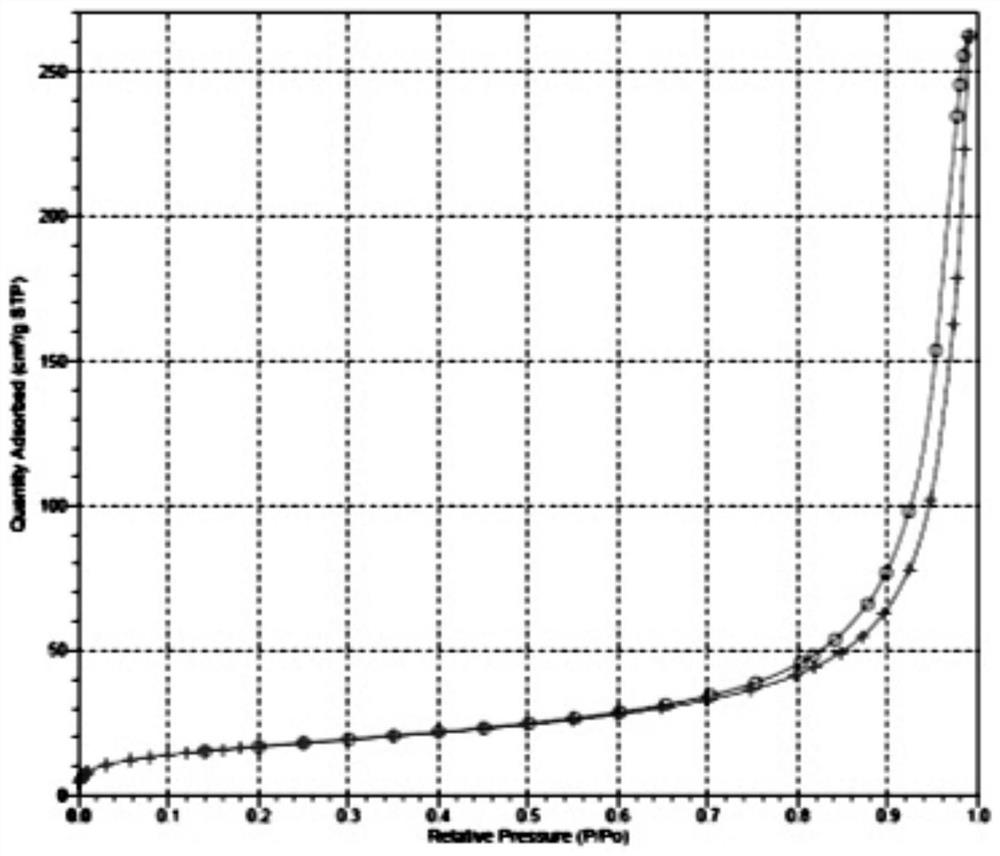A kind of mofs type molecularly imprinted polymer and its preparation method, pesticide residue fluorescence detection method
A technology for pesticide residue and fluorescence detection, applied in fluorescence/phosphorescence, chemical instruments and methods, analytical materials, etc., can solve problems such as difficulty in meeting the needs of grassroots rapid screening and monitoring and early warning, single detection type, and difficulty in preparing biometric molecules.
- Summary
- Abstract
- Description
- Claims
- Application Information
AI Technical Summary
Problems solved by technology
Method used
Image
Examples
Embodiment 1
[0091] This embodiment provides a method for fluorescent detection of pesticide residues, which includes the following steps:
[0092] S1: FeCl 3 ·6H 2 O, FeCl 2 4H 2 O and high-purity water are mixed according to a certain volume ratio and placed in a 250mL three-necked bottle for ultrasonic dispersion for 0.5h; magnetically stirred for 0.5-1h at a temperature of 50-100°C, and a certain volume of NH with a mass fraction of 28% is added 3 ·H 2 O, continue to react for 1 h under the protection of nitrogen; after magnetic separation, use absolute ethanol and pure water to alternately wash several times, and vacuum dry the obtained magnetic nanoparticles Fe 3 o 4 NPs; among them, FeCl 3 ·6H 2 O, FeCl 2 4H 2 The consumption ratio of O, high-purity water and ammoniacal liquor is 0.5g:0.15g:200mL:5mL; The used dehydrated alcohol and high-purity water volume ratio of each washing are 10mL:15-30mL;
[0093] S2: The magnetic nanoparticles Fe 3 o 4 Add NPs and high-purity wa...
Embodiment 2
[0099] It differs from Example 1 in that:
[0100] In step S1, FeCl 3 ·6H 2 O, FeCl 2 4H2 The consumption ratio of O, high-purity water and ammoniacal liquor is 0.6g:0.35g:200mL:10mL; The used dehydrated alcohol and high-purity water volume ratio of each washing are 10mL:25mL.
[0101] In step S2, the magnetic nanoparticles Fe 3 o 4 NPs, high-purity water, FeCl 3 ·6H 2 O, FeCl 3 ·6H 2 O aqueous solution, H 2 The dosage ratio of BDC and DMF is 0.2g:200mL:0.45g:80mL:0.174g:50mL.
[0102] In step S3, the magnetic MOFs composite Fe 3 o 4 - The dosages of MIL-Fe, methanol, acetamiprid molar mass, clothianidin molar mass, APTES, TEOS and acetic acid solution are 0.4g:10mL:0.15mM:0.15mM:0.2mL:2mL, respectively.
Embodiment 3
[0104] It differs from Example 1 in that:
[0105] In step S1, FeCl 3 ·6H 2 O, FeCl 2 4H 2 The consumption ratio of O, high-purity water and ammoniacal liquor is 0.75g:0.45g:200mL:15mL; The used dehydrated alcohol and high-purity water volume ratio of each washing are 10mL:30mL.
[0106] In step S2, the magnetic nanoparticles Fe 3 o 4 NPs, high-purity water, FeCl 3 ·6H 2 O, FeCl 3 ·6H 2 O aqueous solution, H 2 The dosage ratio of BDC and DMF is 0.3g:200mL:0.9g:120mL:0.498g:100mL.
[0107] In step S3, the magnetic MOFs composite Fe 3 o 4 - The dosages of MIL-Fe, methanol, acetamiprid molar mass, clothianidin molar mass, APTES, TEOS and acetic acid solution are 0.5g:10mL:0.2mM:0.2mM:0.4mL:4mL, respectively.
[0108] In conjunction with above-mentioned embodiment and accompanying drawing, refer to figure 1 , MIL-Fe is a blocky three-dimensional highly cross-linked polymer with a non-smooth surface and irregular corners; when Fe 3 o 4 Fe prepared after doping modif...
PUM
| Property | Measurement | Unit |
|---|---|---|
| specific surface area | aaaaa | aaaaa |
| pore size | aaaaa | aaaaa |
Abstract
Description
Claims
Application Information
 Login to View More
Login to View More - Generate Ideas
- Intellectual Property
- Life Sciences
- Materials
- Tech Scout
- Unparalleled Data Quality
- Higher Quality Content
- 60% Fewer Hallucinations
Browse by: Latest US Patents, China's latest patents, Technical Efficacy Thesaurus, Application Domain, Technology Topic, Popular Technical Reports.
© 2025 PatSnap. All rights reserved.Legal|Privacy policy|Modern Slavery Act Transparency Statement|Sitemap|About US| Contact US: help@patsnap.com



